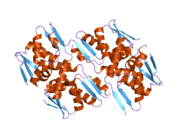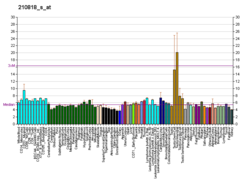BACH1
| BACH1 | |||||||||||||||||||||||||||||||||||||||||||||||||||
|---|---|---|---|---|---|---|---|---|---|---|---|---|---|---|---|---|---|---|---|---|---|---|---|---|---|---|---|---|---|---|---|---|---|---|---|---|---|---|---|---|---|---|---|---|---|---|---|---|---|---|---|
 | |||||||||||||||||||||||||||||||||||||||||||||||||||
| |||||||||||||||||||||||||||||||||||||||||||||||||||
| Identifiers | |||||||||||||||||||||||||||||||||||||||||||||||||||
| Aliases | BACH1, BACH-1, BTBD24, BTB domain and CNC homolog 1 | ||||||||||||||||||||||||||||||||||||||||||||||||||
| External IDs | OMIM: 602751 MGI: 894680 HomoloGene: 916 GeneCards: BACH1 | ||||||||||||||||||||||||||||||||||||||||||||||||||
| |||||||||||||||||||||||||||||||||||||||||||||||||||
| |||||||||||||||||||||||||||||||||||||||||||||||||||
| |||||||||||||||||||||||||||||||||||||||||||||||||||
| |||||||||||||||||||||||||||||||||||||||||||||||||||
| |||||||||||||||||||||||||||||||||||||||||||||||||||
| Wikidata | |||||||||||||||||||||||||||||||||||||||||||||||||||
| |||||||||||||||||||||||||||||||||||||||||||||||||||
Transcription regulator protein BACH1 is a protein that in humans is encoded by the BACH1 gene.[5][6][7]
Function
This gene encodes a transcription factor that belongs to the cap'n'collar type of basic region leucine zipper factor family (CNC-bZip). The encoded protein contains broad complex, tramtrack, bric-a-brac/poxvirus and zinc finger (BTB/POZ) domains, which is atypical of CNC-bZip family members. These BTB/POZ domains facilitate protein-protein interactions and formation of homo- and/or hetero-oligomers. The C-terminus of the protein is a leucine zipper of the bzip_maf family. When this protein forms a heterodimer with MafK, it functions as a repressor of Maf recognition element (MARE) and transcription is repressed. Multiple alternatively spliced transcript variants have been identified for this gene. Some exons of this gene overlap with some exons from the C21orf41 gene, which is transcribed in an opposite orientation to this gene but does not seem to encode a protein.[7]
See also
References
- ^ a b c GRCh38: Ensembl release 89: ENSG00000156273 – Ensembl, May 2017
- ^ a b c GRCm38: Ensembl release 89: ENSMUSG00000025612 – Ensembl, May 2017
- ^ "Human PubMed Reference:". National Center for Biotechnology Information, U.S. National Library of Medicine.
- ^ "Mouse PubMed Reference:". National Center for Biotechnology Information, U.S. National Library of Medicine.
- ^ Blouin JL, Duriaux Saïl G, Guipponi M, Rossier C, Pappasavas MP, Antonarakis SE (Mar 1998). "Isolation of the human BACH1 transcription regulator gene, which maps to chromosome 21q22.1". Human Genetics. 102 (3): 282–8. doi:10.1007/s004390050692. PMID 9544839. S2CID 9494442.
- ^ Ohira M, Seki N, Nagase T, Ishikawa K, Nomura N, Ohara O (Jan 1998). "Characterization of a human homolog (BACH1) of the mouse Bach1 gene encoding a BTB-basic leucine zipper transcription factor and its mapping to chromosome 21q22.1". Genomics. 47 (2): 300–6. doi:10.1006/geno.1997.5080. PMID 9479503.
- ^ a b "Entrez Gene: BACH1 BTB and CNC homology 1, basic leucine zipper transcription factor 1".
Further reading
- Ozono R (Apr 2006). "New biotechnological methods to reduce oxidative stress in the cardiovascular system: focusing on the Bach1/heme oxygenase-1 pathway". Current Pharmaceutical Biotechnology. 7 (2): 87–93. doi:10.2174/138920106776597630. PMID 16724942.
- Oyake T, Itoh K, Motohashi H, Hayashi N, Hoshino H, Nishizawa M, Yamamoto M, Igarashi K (Nov 1996). "Bach proteins belong to a novel family of BTB-basic leucine zipper transcription factors that interact with MafK and regulate transcription through the NF-E2 site". Molecular and Cellular Biology. 16 (11): 6083–95. doi:10.1128/mcb.16.11.6083. PMC 231611. PMID 8887638.
- Bonaldo MF, Lennon G, Soares MB (Sep 1996). "Normalization and subtraction: two approaches to facilitate gene discovery". Genome Research. 6 (9): 791–806. doi:10.1101/gr.6.9.791. PMID 8889548.
- Kobayashi A, Yamagiwa H, Hoshino H, Muto A, Sato K, Morita M, Hayashi N, Yamamoto M, Igarashi K (Mar 2000). "A combinatorial code for gene expression generated by transcription factor Bach2 and MAZR (MAZ-related factor) through the BTB/POZ domain". Molecular and Cellular Biology. 20 (5): 1733–46. doi:10.1128/MCB.20.5.1733-1746.2000. PMC 85356. PMID 10669750.
- Kanezaki R, Toki T, Yokoyama M, Yomogida K, Sugiyama K, Yamamoto M, Igarashi K, Ito E (Mar 2001). "Transcription factor BACH1 is recruited to the nucleus by its novel alternative spliced isoform". The Journal of Biological Chemistry. 276 (10): 7278–84. doi:10.1074/jbc.M004227200. PMID 11069897.
- Cantor SB, Bell DW, Ganesan S, Kass EM, Drapkin R, Grossman S, Wahrer DC, Sgroi DC, Lane WS, Haber DA, Livingston DM (Apr 2001). "BACH1, a novel helicase-like protein, interacts directly with BRCA1 and contributes to its DNA repair function". Cell. 105 (1): 149–60. doi:10.1016/S0092-8674(01)00304-X. PMID 11301010. S2CID 15966253.
- Kitamuro T, Takahashi K, Ogawa K, Udono-Fujimori R, Takeda K, Furuyama K, Nakayama M, Sun J, Fujita H, Hida W, Hattori T, Shirato K, Igarashi K, Shibahara S (Mar 2003). "Bach1 functions as a hypoxia-inducible repressor for the heme oxygenase-1 gene in human cells". The Journal of Biological Chemistry. 278 (11): 9125–33. doi:10.1074/jbc.M209939200. PMID 12511571.
- Suzuki H, Tashiro S, Sun J, Doi H, Satomi S, Igarashi K (Dec 2003). "Cadmium induces nuclear export of Bach1, a transcriptional repressor of heme oxygenase-1 gene". The Journal of Biological Chemistry. 278 (49): 49246–53. doi:10.1074/jbc.M306764200. PMID 14504288.
- Tahara T, Sun J, Nakanishi K, Yamamoto M, Mori H, Saito T, Fujita H, Igarashi K, Taketani S (Feb 2004). "Heme positively regulates the expression of beta-globin at the locus control region via the transcriptional factor Bach1 in erythroid cells". The Journal of Biological Chemistry. 279 (7): 5480–7. doi:10.1074/jbc.M302733200. PMID 14660636.
- Shim KS, Ferrando-Miguel R, Lubec G (2003). "Aberrant protein expression of transcription factors BACH1 and ERG, both encoded on chromosome 21, in brains of patients with Down syndrome and Alzheimer's disease". Advances in Down Syndrome Research. Journal of Neural Transmission Supplement 67. Vol. 67. pp. 39–49. doi:10.1007/978-3-7091-6721-2_3. ISBN 978-3-211-40776-9. PMID 15068237.
{{cite book}}:|journal=ignored (help) - Ferrando-Miguel R, Cheon MS, Yang JW, Lubec G (2003). "Overexpression of transcription factor BACH1 in fetal Down Syndrome brain". Advances in Down Syndrome Research. Journal of Neural Transmission Supplement 67. Vol. 67. pp. 193–205. doi:10.1007/978-3-7091-6721-2_17. ISBN 978-3-211-40776-9. PMID 15068251.
{{cite book}}:|journal=ignored (help) - Suzuki H, Tashiro S, Hira S, Sun J, Yamazaki C, Zenke Y, Ikeda-Saito M, Yoshida M, Igarashi K (Jul 2004). "Heme regulates gene expression by triggering Crm1-dependent nuclear export of Bach1". The EMBO Journal. 23 (13): 2544–53. doi:10.1038/sj.emboj.7600248. PMC 449764. PMID 15175654.
- Tahara T, Sun J, Igarashi K, Taketani S (Nov 2004). "Heme-dependent up-regulation of the alpha-globin gene expression by transcriptional repressor Bach1 in erythroid cells" (PDF). Biochemical and Biophysical Research Communications. 324 (1): 77–85. doi:10.1016/j.bbrc.2004.09.022. PMID 15464985. Archived from the original (PDF) on 2021-04-20. Retrieved 2019-07-11.
- Shan Y, Lambrecht RW, Ghaziani T, Donohue SE, Bonkovsky HL (Dec 2004). "Role of Bach-1 in regulation of heme oxygenase-1 in human liver cells: insights from studies with small interfering RNAS". The Journal of Biological Chemistry. 279 (50): 51769–74. doi:10.1074/jbc.M409463200. PMID 15465821.
- Toki T, Katsuoka F, Kanezaki R, Xu G, Kurotaki H, Sun J, Kamio T, Watanabe S, Tandai S, Terui K, Yagihashi S, Komatsu N, Igarashi K, Yamamoto M, Ito E (Apr 2005). "Transgenic expression of BACH1 transcription factor results in megakaryocytic impairment". Blood. 105 (8): 3100–8. doi:10.1182/blood-2004-07-2826. PMID 15613547.
External links
- BACH1+protein,+human at the U.S. National Library of Medicine Medical Subject Headings (MeSH)
- Human BACH1 genome location and BACH1 gene details page in the UCSC Genome Browser.
This article incorporates text from the United States National Library of Medicine, which is in the public domain.
- v
- t
- e
-
 2ihc: Crystal structure of the bric-a-brac (BTB) domain of human BACH1
2ihc: Crystal structure of the bric-a-brac (BTB) domain of human BACH1
 | This article on a gene on human chromosome 21 is a stub. You can help Wikipedia by expanding it. |
- v
- t
- e




















